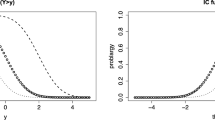Abstract
A number of models for categorical item response data have been proposed in recent years. The models appear to be quite different. However, they may usefully be organized as members of only three distinct classes, within which the models are distinguished only by assumptions and constraints on their parameters. “Difference models” are appropriate for ordered responses, “divide-by-total” models may be used for either ordered or nominal responses, and “left-side added” models are used for multiple-choice responses with guessing. The details of the taxonomy and the models are described in this paper.
Similar content being viewed by others
References
Andersen, E. B. (1973). Conditional inference for multiple choice questionnaires.British Journal of Mathematical and Statistical Psychology, 26, 42–54.
Andrich, D. (1978). A rating formulation for ordered response categories.Psychometrika, 43, 561–573.
Andrich, D. (1982). An extension of the Rasch model for ratings providing both location and dispersion parameters.Psychometrika, 47, 105–113.
Andrich, D. (1985). An elaboration of Guttman scaling with Rasch models for measurement. In N. Brandon-Tuma (Ed.),Sociological methodology (pp. 33–80). San Francisco: Jossey-Bass.
Birnbaum, A. (1968). Some latent trait models and their uses in inferring an examinee's ability. In F. M. Lord & M. R. Novick,Statistical theories of mental rest scores (Part 5, pp. 397–479). Reading, MA: Addison-Wesley.
Bock, R. D. (1972). Estimating item parameters and latent ability when the responses are scored in two or more nominal categories.Psychometrika, 37, 29–51.
Bock, R. D. (1975).Multivariate statistical methods in behavioral research, New York, NY: McGraw Hill.
Bock, R. D., & Aitkin, M. (1981). Marginal maximum likelihood estimation of item parameters: An application of anEM algorithm.Psychometrika, 46, 443–459.
Bock, R. D., & Lieberman, M. (1970). Fitting a response model forn dichotomously scored items.Psychometrika, 35, 179–197.
Choppin, B. (1983).A two-parameter latent trait model. (CSE Report No. 197). Los Angeles, CA: University of California, Center for the Study of Evaluation, Graduate School of Education.
Guttman, L. (1950). The basis for scalogram analysis. In S. A. Stouffer, L. Guttman, E. A. Suchman, P. F. Lazarsfeld, S. A. Star, & J. A. Clausen (Eds.),Measurement and prediction. Princeton, NJ: Princeton University Press.
Lawley, D. N. (1943). On problems connected with item selection and test construction.Proceedings of the Royal Society of Edinburgh, 62-A (Pt. I), 74–82.
Lord, F. M. (1952). A theory of test scores.Psychometrika Monograph No. 7,17 (4, Pt. 2).
Masters, G. N. (1982). A Rasch model for partial credit scoring.Psychometrika, 47, 149–174.
Masters, G. N. (1985). A comparison of latent-trait and latent-class analyses of Likert-type data.Psychometrika, 50, 69–82.
Masters, G. N., & Wright, B. D. (1984). The essential process in a family of measurement models.Psychometrika, 49, 529–544.
Rasch, G. (1960).Probabilistic models for some intelligence and attainment tests. Copenhagen: Denmarks Paedagogiske Institut.
Rasch, G. (1961). On general laws and the meaning of measurement in psychology.Proceedings of the Fourth Berkeley Symposium on Mathematical Statistics and Probability, (pp. 321–333). Berkeley, CA: University of California Press.
Richardson, M. W. (1936). The relationship between difficulty and the differential validity of a test.Psychometrika, 1, 33–49.
Roskam, E. E., & Jansen, P. G. W. (1984). A new derivation of the Rasch model. In E. Defreef & J. Van Buggenhaut (Eds.),Trends in mathematical psychology (pp. 293–307). Amsterdam: Elsevier.
Samejima, F. (1969). Estimation of latent ability using a response pattern of graded scores.Psychometrika Monograph No. 17,34 (4, Pt. 2).
Suppes, P. (1977). Discussion: A critical comparison of models. In H. Spada & W. F. Kempf (Eds.),Structural models of thinking and learning (pp. 21–24). Bern: Hans Huber.
Sympson, J. B. (1983, June).A new IRT model for calibrating multiple choice items. Paper presented at the annual meeting of the Psychometric Society, Los Angeles, CA.
Thissen, D. (1982). Marginal maximum likelihood estimation for the one-parameter logistic model.Psychometrika, 47, 201–214.
Thissen, D., & Steinberg, L. (1984). A response model for multiple choice items.Psychometrika, 49, 501–519.
Tucker, L. R. (1946). Maximum validity of a test with equivalent items.Psychometrika, 11, 1–13.
Winsberg, S., Thissen, D. & Wainer, H. (1983, June).Estimation of the form of the item characteristic curve using monotone splines. Paper presented at the annual meeting of the Psychometric Society, Los Angeles, CA.
Author information
Authors and Affiliations
Additional information
The present study was supported in part by two postdoctoral fellowships awarded to Lynne Steinberg: an Educational Testing Service Postdoctoral Fellowship at ETS, Princeton, NJ and an NIMH Individual National Research Service Award at Stanford University, Stanford, CA. Helpful comments by the editor and three anonymous reviewers are gratefully acknowledged.
Rights and permissions
About this article
Cite this article
Thissen, D., Steinberg, L. A taxonomy of item response models. Psychometrika 51, 567–577 (1986). https://doi.org/10.1007/BF02295596
Received:
Revised:
Issue Date:
DOI: https://doi.org/10.1007/BF02295596




